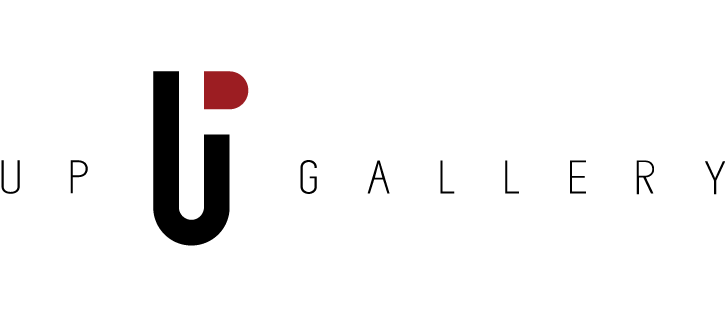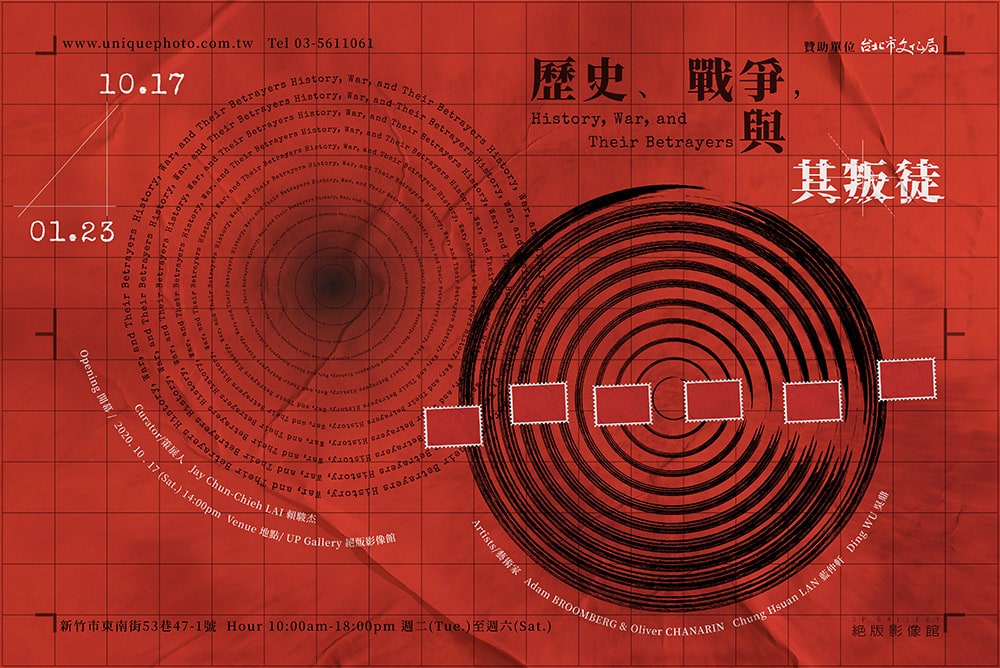EXHIBITIONS
Exhibitions ─ Previous
History, War, and Their Betrayers
In the past, image was an aid that served actual warfare’s and conflicts. It has now, however, become a weapon, wielding in battlefields.
In the past, image was an aid that served actual warfare’s and conflicts. It has now, however, become a weapon, wielding in battlefields.
Curator| Jay Chun-Chieh LAI
Artist|Adam BROOMBERG & Oliver CHANARIN, Ding WU, Chung Hsuan LAN
Duration|2020.10.17~2021.01.23
Opening|2020.10.17 (Sat.) 14:00
Venue|UP Gallery
Text by Jay Chun-Chieh LAI
If the writing of history is to be comprehended as simply a linear progression (of events), one might find “war” one of the most prominent and direct factors that affect the development of human history. Wars that were provoked by human occurrences like revolutions, border conflicts, and military coups. In more recent times, historical writing has adopted a new approach. It underscores a historical discourse that centers on locality wherein varieties and multiplicity are highlighted. It also focuses on distinctive culture, habitus as well as ethnic consciousness, and its legacy. Yet, “war” has never ended. It conceals itself and dives even deeper, disguising itself into different forms and shapes the way history is written.
Because of its remarkable liquidity, mobility, and ability to differentiate specific groups of audiences (in art, experimental cinema, documentary, photojournalism, and entertainment), image becomes one of the best tools to expand battlefields. However, the collaboration between image and history is liable to collapse because of their deceptive and devious nature. Image with its illusory power fundamentally contradicts with the logical reasoning in writing. Their mutual exclusiveness dooms their destiny to be the shadow of each other. Yet it also entices constant attempts of the two parties to escape from their fate, hoping to replace their adversary. Such a notion permeates the artistic approach of the three participating artists whose works endeavour to probe into the so-called “escape” and “replacement” and bring forth possibilities.
Afterlife is a series of 17 pieces of transparent glass boards created by the artist duo Adam Broomberg & Oliver Chanarin. The work was adapted from a series of photos taken on the 27th August 1979 by journalist Jahangir Razmi during the war of Iran. The original photos captured the scene of an execution and won the Pulitzer Prize for Photography in 1982. The identity of the photographer was only revealed later in 2006, making the 1982 prize the only time that has an anonymous winner. The group created the artworks by making individual characters (both the executed and the executioners) into collages and titled it Afterlife with an ironic undertone. When the horrifying narrative is taken out from the war images, these collages emerge as a series of light-hearted dance moves, performing the very act of death. It was the portraits, not the background, that was removed. The empty background occupied by the images of the people has indeed manifested the essence of historical background. Its voidness and transparent nature speak no less than the historical documents and the media archives.
Similar to Adam and Oliver, the artist Lan Chung-Hsuan’s God, Goddess, and Trinity is anti-image or more precisely, iconoclastic. The celebrity Teresa Teng (1953-1995) is portrayed in his work as the goddess, and the way it was articulated (clearly as a sort of apparatus for propaganda) becomes the targeted opponent which the artist Lan provokes to fight against. The goddess is not beautiful anymore, and the appearances of heroes become unrecognisable. The Begonia leaves with the shape of China is the metaphor of the place that is unable to return. Teresa Teng’s face is covered by a Latin alphabet θ which means “death” in Ancient Greece and Rome. The alphabet assembled by red stamps imbued the image with an apparent ominous connotation. The “death” presented in the work, however, is somehow a stage in a cycle that revolves and ultimately reaches “birth”. The cycle is a typical representation of the trinity of Party/Government/Religion that serves as a national belief. In this sense, “death“ has become “immortality”.
Wu Ding’s artistic approach revolves around the writing of history and time as well as their counter-relationship to image even though he never employs the idea of war as the theme of his practices. Wu’s works are relatively abstract and cold, and he is convinced that things happen and go with the flow of development and its chronological route. The only thing that we, as humans, can do is to try to co-exist with it. History, on the other side, always pushes us to move forward. He is not trying to destroy the image/icon using external strength, but the works occupy themselves within the fissure of image and text. They represent the interdependent but conflicting relationship between words and images, which is located in the “vacuum zone” wherein words and images lost their functions by the différance of the unspeakable and the unimaginable. With his calm tone, as usual, Wu’s works distort the route on which history proceeds towards the magnificent future. They pierce through the other participating artists’ works, drawing us back to the abyss composed of nothing but the repeated cycle, and urge us to re-anchor ourselves back into the coordination of rules and norms.
This exhibition aims not to discern and explore any specific (history of) war by these three groups of artists, nor is it trying to touch upon issues concerning the “image of war and its horror”. The title, however, reveals the potential subject of knowledge which is historical writing and image-making, their various contradictory relationships with ideologies, and how it can be seen as an expansion of the word/image problem. The artists share common interests and intentions in historical writing with a versatile display of forms, methods, and routes. The exhibition begins with the artist duo presenting to us the absence (death) of the written and the ones with the power of writing history. It then introduced to us Lan’s works that delineate the immortal historical cycle through the concept of trinity. The audience would then find themselves being brought to the sensational space set up by the artist Wu Ding where ideologies of three groups of artists are enclosed within. The exhibition tries to dissolve and transform the birth and death of history, which is perfectly articulated in Wu’s video Meditation by the turbid gas floating between the images and words. To discuss world war and human history undoubtedly requires more than three groups of artists and works, yet the exhibition draws a topological map by which the audiences can get a glimpse of what Taiwan faces now, in face of the current situation between the U.S and China in the post-Cold War era.
About The Curator
JAY Chun-Chieh LAI(b.1983 Tainan, Taiwan)
Studied Fine Arts (BA), Art Criticism (MA) and received an MFA degree in Curating (2014-16) from Goldsmiths, University of London. He had a few years of experience as an independent curator as well as a freelance writer and worked in an NGO art organisation and art museum. He has curated exhibitions across not-for-profit art centres and commercial galleries, such as the Taipei Contemporary Art Centre (TCAC) and the Aki Gallery (Taipei), Hong-gah Museum, ModeA Contemporary Space (Xiamen), and Taiwan National Museum of Fine Arts (Taichung). He has had more than fifty articles and essays published in major art magazines, including Artco (Taipei), ArtWorld (Shanghai), and ArtZip (London), and now as a member of AICA (International Association of Art Critics, UNESCO). He spent a year in Paris before going to London. His research interests cover issues such as word-image relations, moving images, and curatorial studies. Recent curatorial proposals that he’s working on are seeking to revise the previously ignored action modes in everyday life, namely “listening/ speaking/ reading/ writing”, intending to reform a scheme for actioners to co-exist with the world. Radical Forms of Writing, as the first episodic exhibition, has been presented at Hong-gah Museum (Taipei), from April until June 2017.
About the Artists
Adam Broomberg & Oliver Chanarin
Adam Broomberg (b.1970, Johannesburg, South Africa) and Oliver Chanarin (b. 1971, London, UK) are artists living and working between London and Berlin. They are professors of photography at the Hochschule für bildende Künste (HFBK) in Hamburg and teach on the MA Photography & Society programme at The Royal Academy of Art (KABK), The Hague which they co-designed. Together they have had numerous solo exhibitions most recently at The Centre Georges Pompidou (2018) and the Hasselblad Center (2017). Their participation in international group shows includes the Yokohama Trienniale (2017), Documenta, Kassel (2017), The British Art Show 8 (2015-2017), Conflict, Time, Photography at Tate Modern (2015); Shanghai Biennale (2014); Museum of Modern Art, New York (2014); Tate Britain (2014), and the Gwanju Biennale (2012). Their work is held in major public and private collections including Pompidou, Tate, MoMA, Yale, Stedelijk, V&A, the Art Gallery of Ontario, Cleveland Museum of Art, and Baltimore Museum of Art. Major awards include the ICP Infinity Award (2014) for Holy Bible and the Deutsche Börse Photography Prize (2013) for War Primer 2. Broomberg and Chanarin are the winners of the Arles Photo Text Award 2018 for their paper back edition of War Primer 2, published by MACK.
Ding WU(b.1982, Shanghai, China)
Currently lives and works in Shanghai. In 2017, he graduated with a master’s degree in contemporary image creation and research from the School of Intermedia, China Academy of Art. He has been committed to the exploration and practical creation of images for a long time. The main media of his creation include text, graphic photography, and dynamic images. Recent works continue to focus on the “order” formed in time and space, hoping to explore the “inner order” that can only be perceived but not spoken in this world-perhaps it is the only fulcrum that supports this world. Recent exhibition experiences include The History of the Circle II (solo exhibition), Art Museum of China Academy of Art, Hangzhou, 2019; The History of the Circle I (solo exhibition), Jimei Arles International Photography Festival, Xiamen, 2019; Border Effect, Today Art Museum, Beijing, 2018; The Rhythm of Ultimate II (solo exhibition), East Gallery, Shanghai, 2017; The Rhythm of Ultimate I (solo exhibition), Shanghai Minsheng Art Museum, Shanghai, 2016; We, K11 Art Museum, Shanghai, 2016; The Dimension of Reality III (solo exhibition), M50 Art Center, Shanghai, 2015. His works have been shortlisted for the 2019 Xiamen Jimei Arles Discovery Award & 2014 Sanya Huayu Youth Award; in 2015, he participated in the British CFCCA residency & 2016 Korean Cultural Center residency.
Chung Hsuan LAN (b.1991, Taipei, Taiwan)
Chung Hsuan LAN holds an MFA in Fine Arts from Pratt Institute, New York. From his photography, image-based art, readymades, and installations, Lan represents the history of aviation, war, and disaster in the contemporary with his aesthetic to transform our catastrophic moments. His recent exhibitions include group show “Love Songs” at Each Modern, Taipei, 2020, solo show “Perpetuity’s Itinerants” at MIT Award, Taipei, 2019, solo show “Dielusion” at 3331 Arts Chiyoda, Tokyo, Japan, group show “Dizygotic Intergrowth” at Pingyao Photography Festival, China, 2018, and group show “TES Taiwan VII” at Aki Gallery, Taipei. Participated in residency programs include 3331 Arts Chiyoda, Tokyo, Japan, 2018, and Arteles Creative Center, Hämeenkyrö, Finland, 2017. Awards include Merit Award, TDCC Contemporary Arts Award, 2020, Judges’ List Award, YiLan Art Award, 2019, and Excellence Award, Shin Leh Yuan Art Space, 2018. Lan currently lives and works in Taipei, Taiwan.



